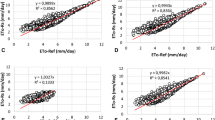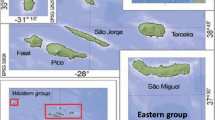Abstract
Numerous equations exist for estimating reference evapotranspiration (ETo). Relationships were often subject to rigorous local calibration, hence having limited global validity. The Penman–Monteith (P − M) equation is widely perceived as the best equation for estimating daily and monthly ETo in all climates. The main shortcoming of the P − M equation is that it requires numerous weather data that may not always be available. This study evaluates the methods to estimate missing data in the context of their influence on the performance of the ETo equations. The performance of other ETo equations under missing data are also compared. ETo equations are ranked individually in semi − humid and semi − arid climates based on their accuracy. Results indicate that the P − M equation is more sensitive in semi − arid climate than semi − humid climate under missing data conditions. The accuracy of the P − M equation under these conditions increases remarkably if any available relationships between dew point and minimum temperatures and also long–term average wind speed for each station are exploited. Finally, the minimum data requirements necessary for adequate performance of the P − M equation are air temperature for semi − humid climates, air temperature and wind speed for semi − arid climates, and the availability of a relationship between dew point and minimum temperature, especially for semi − arid climate. In absence of the satisfaction of such minimum requirements, the Hargreaves–Samani equation is preferable for semi − humid climates and the Hargreaves equation modified by Droogers and Allen (2002) for semi − arid climates.




Similar content being viewed by others
References
Ababaei B (2014) Are weather generators robust tools to study daily reference evapotranspiration and irrigation requirement? Water Resour Manag 28:915–932
Abghari H, Ahmadi H, Besharat S, Rezaverdinejad V (2012) Prediction of daily pan evaporation using wavelet neural networks. Water Resour Manag 26:3639–3652
Allen RG (1996) Assessing integrity of weather data for reference evapotranspiration estimation. J Irrig Drain Eng 122(2):97–106
Allen RG, Pereira LS, Raes D, Smith M (1998) Crop evapotranpiration: guildlines for computing crop water requirements, fao irrigation and drainage paper no 56. Food and Agriculture Organisation, Land and Water, Rome
Cai J, Liu Y, Lei T, Pereira LS (2007) Estimating reference evapotranspiration with the FAO Penman–Monteith equation using daily weather forecast messages. Agric For Meteorol 145(1):22–35
Chauhan S, Shrivastava RK (2009) Performance evaluation of reference evapotranspiration estimation using climate based methods and artificial neural networks. Water Resour Manag 23:825–837
Chiew FHS, Kamaladassa NN, Malano HM, McMahon TA (1995) Penman–Monteith, FAO–24 reference crop evapotranspiration and class–a pan data in Austrelia. Agric Water Manag 28(1):9–21
Citakoglu H, Cobaner M, Haktanir T, Kisi O (2014) Estimation of monthly mean reference evapotranspiration in Turkey. Water Resour Manag 28:99–113
Doorenbos J, Kassam AH (1979) Yield response to water. FAO irrigation and drainage paper No. 33. Rome, FAO
Doorenbos J, Pruitt WO (1975) Guidelines for predicting crop water requirements, irrigation and drainage paper no. 24, FAO–ONU, Rome, Italy. 168pp
Droogers P, Allen RG (2002) Estimating reference evapotranspiration under inaccurate data conditions. Irrig Drain Syst 16(1):33–45
Esmaeili A, Vazirzadeh S (2009) Water pricing for agricultural production in the South of Iran. Water Resour Manag 23:957–964
Fischer G, Tubiello H, Velthuizen V, Wiberg D (2006) Climate change impacts on irrigation water requirements: global and regional effects of mitigation. Technol Forecast Soc 74:1990–2080
Garcia M, Raes D, Allen RG, Herbas C (2006) Dynamics of reference evapotranspiration in the Bolivian highlands (Altiplano). Agric Forest Meteorol 125:67–82
Gavilán P, Lorite IJ, Tornero S, Berenjena J (2006) Regional calibration of Hargreaves equation for estimating reference ET in a semiarid environment. Agric Water Manag 81:257–281
Gavilán P, Berengena J, Allen RG (2007) Measuring versus estimating net radiation and soil heat flux: impact on penman–Monteith reference ET estimates in semiarid regions. Agric Water Manag 89(3):275–286
George BA, Reddy BRS, Raghuwanshi NS, Wallender WW (2002) Decision support system for estimating reference evapotranspiration. J Irrig Drain Eng 128(1):1–10
Hargreaves GH, Samani ZA (1985) Reference crop evapotranspiration from temperature. Trans ASAE 28(1):96–99
Hargreaves LG, Hargreaves GH, Riley JP (1985) Irrigation water requirements for Senegal river basin. J Irrig Drain Eng 111(3):265–275
Hess TM (1998) Trends in reference evapo–transpiration in the North East arid zone of Nigeria. J Arid Environ 38:99–115
Jensen ME, Haise HR (1963) Estimating evapotranspiration from solar radiation. J Irrig Drain Div Proc Am Soc Civ Eng 89:15–41
Jensen ME, Burman RD, Allen RG (1990) Evapotranspiration and irrigation water requirements. ASCE manuals and reports on engineering practice No. 70, ASCE, New York
Kimball JS, Running SW, Nemani R (1997) An improved method for estimating surface humidity from daily minimum temperature. Agric Forest Meteorol 85(1–2):87–98
Kisi O, Cengiz TM (2013) Fuzzy genetic approach for estimating reference evapotranspiration of Turkey: Mediterranean region. Water Resour Manag 27:3541–3553
Llasat MC, Snyder RL (1998) Data error effects on net radiation and evapotranspiration estimation. Agric Forest Meteorol 91(3–4):209–221
Lopez–Urrea R, De Santa Olalla FM, Fabeiro C, Moratalla A (2006) An evaluation of two hourly reference evapotranspiration equations for semiarid conditions. Agric Water Manag 86(3):277–282
Martinez–Cob A, Tejero–Juste M (2004) A wind–based qualitative calibration of the Hargreaves ETo estimation equation in semiarid regions. Agric Water Manag 64:251–264
Nandagiri L, Kovoor GM (2006) Performance evaluation of reference evapotranspiration equations across a range of Indian climates. J Irrig Drain Eng 132(3):238–249
Nash JE, Sutcliffe JV (1970) River flow forecasting through conceptual models: 1. A discussion on principles. J Hydrol 10:45–51
Pereira LS (2005) Water and agriculture: facing water scarcity and environmental challenges. Agric Eng Int CIGR E J 7:1–26
Pereira AR, Pruitt WO (2004) Adaptation of the thornthwaite scheme for estimating daily reference evapotranspiration. Agric Water Manag 66(3):251–257
Perugu M, Singam AJ, Kamasani CSR (2013) Multiple linear correlation analysis of daily reference evapotranspiration. Water Resour Manag 27:1489–1500
Rahimikhoob A (2014) Comparison between M5 model tree and neural networks for estimating reference evapotranspiration in an arid environment. Water Resour Manag 28:657–669
Rahimikhoob A, Behbahani MR, Fakheri J (2012) An evaluation of four reference evapotranspiration models in a subtropical climate. Water Resour Manag 26:2867–2881
Rahimikhoob A, Asadi M, Mashal M (2013) A comparison between conventional and M5 model tree methods for converting pan evaporation to reference evapotranspiration for semi-arid region. Water Resour Manag 27:4815–4826
Ravelli F, Rota P (1999) monthly frequency maps of reference crop evapotranspiration and crop water deficits in southern italy. irrigation experimentation office of the former Southern Italy development agency, Rome, Italy
Todorovic M (1999) Single–layer evapotranspiration model with variable canopy resistance. J Irrig Drain Eng 125(5):235–245
Trachkovich S, Kolakovich S (2009a) Evaluation of reference evapotranspiration equations under humid conditions. Water Resour Manag 23:3057–3067
Trachkovich S, Kolakovich S (2009b) Wind–adjusted Turc equation for estimating reference evapotranspiration at humid European locations. Hydrol Res 40(1):45–52
Trachkovich S, Kolakovich S (2009c) Estimating reference evapotranspiration using limited weather data. J Irrig Drain Eng 135(4):443–449
Trajkovic S (2007) Hargreaves versus Penman–Monteith under humid conditions. J Irrig Drain Eng 133(1):38–42
Turc L (1961) Estimation des besoins en eau d’irrigation, evapotranspiration potentielle, formule climatique simplifiee et mise a jour. Ann Agron 12(1):13–49
Vanderlinden K, Giraldez JV, Van Meirvenne M (2004) Assessing reference evapotranspiration by the Hargreaves method in Southern Spain. J Irrig Drain Eng 130(3):184–191
Ventura F, Spano D, Duce P, Snyder RL (1999) An evaluation of common evapotranspiration equations. Nuovo Cimento della Soc Ital di Fis Nucl Part Fields 18(4):163–170
Xu C–Y, Singh VP (2002) Cross comparison of empirical equations for calculating potential evapotranspiration with data from Switzerland. Water Resour Manag 16:197–219
Zhao C, Nan Z, Cheng G (2005) Evaluating methods of estimating and modelling spartial distribution of evapotranspiration in the Middle Heihe River Basin, China. Am J Environ Sci 1(4):278–285
Acknowledgments
The authors would like to thank the anonymous reviewers for their precious and insightful comments and suggestions that greatly improved the quality of this manuscript.
Author information
Authors and Affiliations
Corresponding author
Rights and permissions
About this article
Cite this article
Majidi, M., Alizadeh, A., Vazifedoust, M. et al. Analysis of the Effect of Missing Weather Data on Estimating Daily Reference Evapotranspiration Under Different Climatic Conditions. Water Resour Manage 29, 2107–2124 (2015). https://doi.org/10.1007/s11269-014-0782-0
Received:
Accepted:
Published:
Issue Date:
DOI: https://doi.org/10.1007/s11269-014-0782-0




